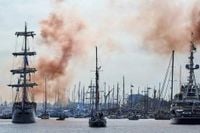Amsterdam’s legendary waterways came alive on August 21, 2025, as hundreds of historic ships from around the globe sailed into the city, marking the triumphant return of SAIL—the Dutch capital’s iconic maritime festival. For the first time in a decade, the event drew massive crowds to the banks of the North Sea Canal and the IJ waterway, eager to witness a spectacle that has been part of the city’s fabric for generations.
According to reports from the Associated Press, vantage points along one of Amsterdam’s major canals were packed with onlookers, while many locals and tourists alike took to the water themselves, crowding the city’s famous waterways in everything from small dinghies to elegant pleasure boats. The excitement was palpable as the five-day festival kicked off, a celebration of Amsterdam’s rich maritime heritage that has long captivated residents and visitors alike.
SAIL 2025 is no ordinary festival. The event, which typically occurs every five years, was last held in 2015. The 2020 edition, like so many other major gatherings around the world, was cancelled due to the COVID-19 pandemic. This year’s return was met with a sense of anticipation and relief—a long-awaited revival after a decade-long hiatus, as reported by Mid-day.
The festival’s centerpiece is a grand flotilla of historic ships. Vessels from all corners of the world—some with storied pasts, others lovingly restored for the occasion—made their way from the North Sea coastal town of IJmuiden. Their journey up the North Sea Canal and into Amsterdam’s IJ waterway is a tradition steeped in history, and this year’s parade was as colorful and dramatic as ever. Each ship’s masts and rigging were festooned with flags, fluttering in the summer breeze, creating a vibrant tableau against the city’s skyline.
The procession itself is a carefully choreographed affair. As each ship enters the harbor, it is greeted by two thunderous cannon shots, followed by the playing of its country’s national anthem. This ritual, described by Mid-day, is both a nod to naval tradition and a celebration of the international spirit that defines SAIL. The sound of cannons echoing across the water, mingling with strains of music from around the world, set the tone for a festival that is as much about unity as it is about history.
Hundreds of smaller vessels joined the parade, packing the waterways to get a closer look at the historic ships as they made their stately entrance. The scene was one of joyful chaos—boats jockeying for position, passengers waving flags and snapping photos, and the city’s bridges lined with spectators craning for a better view. For many, it was a chance to connect with the city’s maritime roots, to feel, if only for a moment, part of a living tradition.
The origins of SAIL Amsterdam date back to 1975, when the city hosted a parade of tall ships to mark its 700th anniversary. The event was such a success that it became a recurring festival, drawing ships and visitors from across the globe. Over the years, SAIL has evolved into one of the world’s largest nautical events, a showcase for historic vessels and a celebration of the seafaring spirit that has shaped the Netherlands for centuries.
But SAIL is more than just a parade of ships. The festival features a packed program of cultural events, concerts, and exhibitions, all designed to highlight the city’s maritime legacy. Museums open their doors for special displays, artists line the quays with nautical-themed works, and food stalls serve up traditional Dutch fare alongside international favorites. For five days, the city’s waterfront becomes a stage for performers, historians, and sailors alike.
The cancellation of the 2020 edition due to the pandemic cast a long shadow over the festival’s future. Many feared that the break in tradition might dampen enthusiasm or lead to logistical challenges. But the turnout this year suggests otherwise. According to the Associated Press, crowds were as large and enthusiastic as ever, a testament to the enduring appeal of SAIL and the resilience of Amsterdam’s cultural life.
“It’s wonderful to see the ships return and the city come alive,” said one festival-goer, echoing the sentiments of many who lined the canals. The sense of community was unmistakable, as people from all walks of life came together to celebrate a shared heritage. The ships themselves, many of which have sailed through wars, storms, and decades of service, seemed to embody that spirit of endurance.
The international flavor of the event was especially pronounced this year. Ships from dozens of countries participated, each greeted with its own anthem and a round of applause. The sight of so many flags—Dutch, British, Russian, American, and more—fluttering side by side was a powerful reminder of the city’s historic role as a crossroads of trade and culture.
For the sailors and shipowners, SAIL is both a homecoming and a showcase. Many spend years restoring their vessels, preparing for the chance to join the parade. The festival offers an opportunity to swap stories, share techniques, and inspire a new generation of maritime enthusiasts. For some, it’s a labor of love; for others, a family tradition passed down through generations.
Local businesses, too, benefit from the influx of visitors. Hotels and restaurants reported brisk trade, and souvenir shops did a roaring business in nautical-themed memorabilia. The economic impact of SAIL is significant, providing a boost to the city’s tourism sector and reinforcing Amsterdam’s reputation as a world-class destination.
Yet, for all its spectacle, SAIL is also a moment of reflection. The festival invites participants to consider the role of the sea in shaping the Dutch identity—the dangers faced by sailors, the fortunes won and lost in trade, and the ongoing challenges of preserving historic vessels in an age of rapid change. It’s a living history lesson, played out against the backdrop of one of Europe’s most beautiful cities.
As the sun set on the first day of SAIL 2025, the city’s canals glowed with the light of lanterns and the sound of laughter. For many, the memory of this year’s festival will linger long after the ships have departed, a reminder of the ties that bind Amsterdam to the sea—and to the world beyond its shores.





